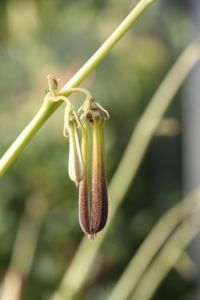A strange name for a strange plant, even stranger is the other name it is known by, namely: Spathulopetalum dicupuae; I will stick to Caralluma. It has a different growth to what one normally associates with Stapelias: when they are going to flower, the stems elongate producing flowers along the extended growth. These elongated parts can be anything between 14 and 20 cm long and the flower lobes themselves are 2 cm long. There are about 15 species of this type of Caralluma found in Eastern Africa and one or two in India.
The plant comes from eastern Kenya around Archers post which is north of Isiolo. This is a very dry part of the country with only sporadic rainfall. It is also a very hot area, therefore the plant in cultivation must be kept at a high temperature all the year round, at least 15° C, but preferably warmer. Because it requires such high temperatures, it is a rare Stapeliad in cultivation. It can be grown in the full sun where it will get the red-mottling on the stems, otherwise it will remain green. They require very little water throughout the year, so it is best to use a very open compost with plenty of grit.
Stapelia
September 16, 2012
Caralluma dicapuae Archers post
Posted by pshirley under Asclepiads, Collection, Stapelia | Tags: Kenya, Stapelia |Leave a Comment
July 14, 2012
Orbeanthus conjunctus
Posted by pshirley under Asclepiads, Collection, Stapelia | Tags: asclepiad, South-Africa, Stapelia |Leave a Comment
This plant is also known as Stultitia conjuncta, but in 1978 it was moved to Orbeanthus. Recently, Peter Bruyns, one of the top Stapelia people, has placed it in Orbea, but there is a lot of movement in the naming of Stapelias, so it is entirely possible that it will be moved back to Orbeanthus. This genus contains only two species; the other one being Orbeanthus hardyi.
It is not a common plant in cultivation, but is very suitable for a hanging pot; the stems can grow up to 50 cm in length and are greyish green mottled with darker green. The flowers are cup-shaped and look similar to those of Hoya archboldiana, the colour being white with a red centre. The flowers are produced singly or in pairs, mainly in the summer.
It requires a well-drained soil, preferably mixed with grit. Propagation is by seed or cuttings. Cuttings need to dry for a couple of days before being put in the soil to avoid rot, as is the case with most succulents. Bottom-heat is preferred to speed up rooting. The plants can be grown either in full sun or shade, but you will get more mottling on the stem if they are kept in the sun.

Orbeanthus conjunctus
July 30, 2011
Huernia zebrina ssp. magnifica
Posted by pshirley under Asclepiads, Collection, Stapelia | Tags: Africa, Huernia |1 Comment
This species comes from southern Africa; it is reasonably easy to grow and is very popular because of its large flowers. The flowering period is July-October. Because of the thick ring around the centre of the flower, it is also listed as one of the ‘lifebuoy Huernias’.
The plant requires a minimum temperature of 10-15°C in winter to do well. It is easily propagated by cuttings which can be left to dry for about a week or so before planting. In the greenhouse it prefers to be kept in the shade as too much exposure to the sun can cause burning.
Not all experts class this subspecies as magnifica, but as ssp. zebrina, but they all mean the same plant. If you want to read more about this species, see: P.V. Bruyns, Stapeliads of Southern Africa and Madagascar, volume 1, pp. 168-172.

Huernia zebrina var. magnifica
May 14, 2011
Caralluma dummeri
Posted by pshirley under Collection, Stapelia, Website | Tags: Kenya, Stapelia |[2] Comments
This caralluma is now officially called Orbea dummeri, but many people still know it as Caralluma dummeri. This plant was collected by me at Marble Quarry near Nairobi in Kenya. It likes a fairly high winter temperature, somewhere between 10 and 15°C to do well. It is easily propagated by breaking off the stems, dying them for a couple of weeks and placing them in the soil again.
They can be grown in the full sun, but it seems to do better in slight shade. It is one of the few stapelias that has bright green flowers which is quite unusual for the genus. They are not scented, bad or otherwise, so worth having in your collection.

Caralluma dummeri
November 14, 2010
Cultivation
Posted by pshirley under Ceropegia, Epiphyllium, Hoya, Impatiens, Rhipsalis, Stapelia, Website | Tags: cultivation |[3] Comments
Many people ask me how to grow the cuttings they have ordered from my webshop. Instead of answering each customer individually by mail, I have added a page to the website with cultivation notes for the various groups I sell: Ceropegia, Epiphyllium, Hoya, Impatiens, Rhipsalis and Stapelia. These are general notes on how to treat the cuttings once they arrive and how to grow them on. It is of course not a complete manual with every exception listed, but I thought that these instructions might be helpful.
June 11, 2010
The new Stapelia list is online. Due to the severe and long winter, some sorts have unfortunately not survived, so the list is not as long as I would have liked, but there is plenty left to choose from. A new photograph is the Huernia macrocarpa, a South-African species – just in time for the football world cup.





